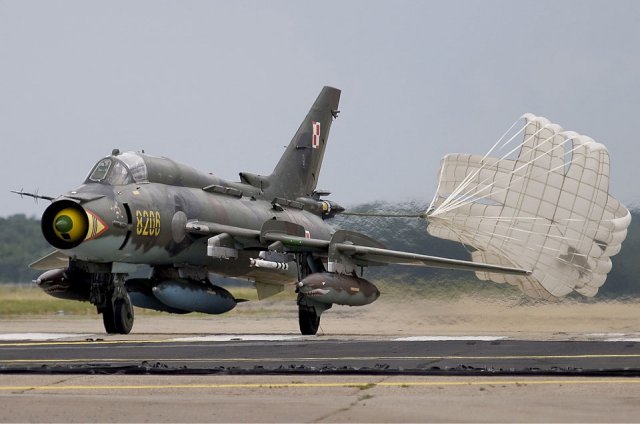Warsaw is backtracking on its decision to withdraw 32 Sukhoi Su-22 strike fighters from service by 2015, and replace them with armed unmanned aircraft systems (UAS). Defence Minister Tomasz Siemoniak confirmed recently that the 32 Sukhoi-22s stationed at Swidwin will remain in service for at least 3 years, or even 10.
Swidwin currently operates single seater Su-22MK4 strike fighters and Su-22UMK3 two–seater variants (NATO reporting name “Fitter”), used for operational conversion training. The aircraft will be maintained in service at least until 2017. If those fighters will be retained for 10 years, the number of remaining jets is expected to shrink from the two operational squadrons into a single squadron, operating 16 aircraft.
To maintain the force structure the Polish Air Force could acquire more F-16C/Ds, combining the procurement with mid-life upgrades of its current F-16s.
Two Israeli platforms – the Hermes 900 from Elbit Systems and Heron I from IAI – were proposed as alternatives. At the time, Elbit Systems’ Hermes 900 seemed to be superior to the Heron I that IAI was able to offer (at least in terms of the mission payload capability and flexibility – 300 kg vs 250 kg). Moreover, the evolution of Hermes 900 from the Hermes 450 the Israel Defense Forces is already operating for similar applications has positioned the ’900 as the most likely choice for the Poles, a view expressed by Skrzypczak in correspondence with Israel’s director of defence exports. After this letter was leaked to the press, as it was written during the selection process, Skrzypczak resigned in November 2013, amid allegations of favouring foreign arms suppliers.
Leaking Skrzypczak’s letter to the press could have happened either in Tel Aviv or Warsaw.  In Warsaw, Skrzypczak has gathered enough enemies in the MOD to bring about such action, over his harsh criticism over the Polish procurement processes in his past positions as commander of the army. In Tel Aviv, the feud between Elbit Systems and IAI has already caused many casualties, in Israel and abroad. Whoever caused the leak has not been determined, but the doubt that it could have caused the resignation of a friendly and respected general of a foreign nation could not be tolerated.
In Warsaw, Skrzypczak has gathered enough enemies in the MOD to bring about such action, over his harsh criticism over the Polish procurement processes in his past positions as commander of the army. In Tel Aviv, the feud between Elbit Systems and IAI has already caused many casualties, in Israel and abroad. Whoever caused the leak has not been determined, but the doubt that it could have caused the resignation of a friendly and respected general of a foreign nation could not be tolerated.
Following Skrzypczak’s resignation Dan Harel, the Director General of Israel’s Ministry of Defence (IMOD) tried to bring the two Israeli rivals to join fores by ‘nationalizing’ the programme – by turning it into a Government-to-Government sale (as was previously done in the sale of Heron UAS to Turkey, where the two companies shared the sales package providing different elements of the whole system).
As the two companies refused such a plan, the IMOD pulled the two Israeli companies out of the Polish competition, denying them an export license. These harsh measures are likely to be temporary, given the leading position in the selection process and the fact that there was no allegation of wrong doing from either side. The Polish decision to delay the retirement of the Su-22 for at least three years will give the Israelis time to cool down. Originally, the Polish plans were to field the new armed UAS capability by 2018, a schedule that could coincide with the three-year life extension given to the Fitters.
If the Poles decide to keep their Fitters extra 10 years, that decision opens a new opportunity for the modernisation of these ageing strike fighters, which have never been upgraded since their fielding back in the 1980s. This could bring an opportunity where the two Israeli rivals could find themselves competing again – as both Elbit Systems and IAI carried out upgrades of similar Russian-made aircraft in the past.
Photos:
Top: Su-22 Fitter strike fighter – Chris Lofting
Lower: General (ret) Waldemar Skrzypczak
Source: Defense Update

